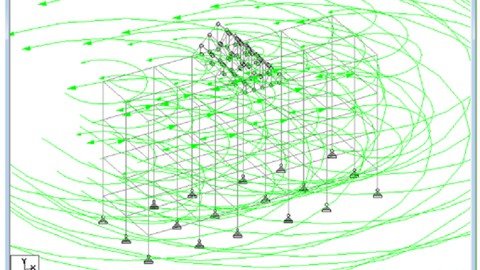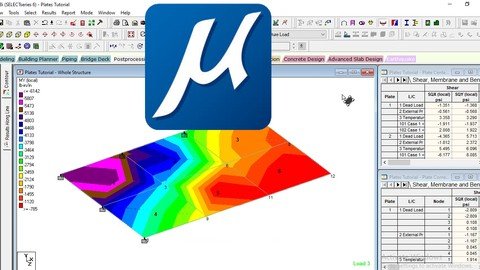STAAD Foundation Advanced CONNECT Edition Update 7 Patch 1
"softddl.org"
22-08-2022, 05:44
-
Share on social networks:
-
Download for free: STAAD
-
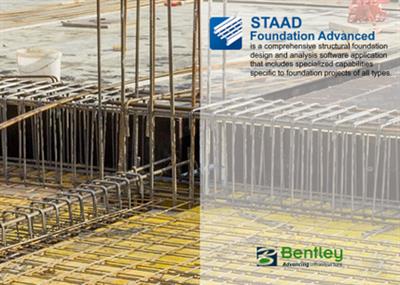
STAAD Foundation Advanced CONNECT Edition Update 7 Patch 1 | 796.5 mb
The Bentley's STAAD development team is pleased to announce the availability of STAAD Foundation Advanced CONNECT Edition Update 7 patch 1 (09.07.01.139). This software is used for the analysis and design of isolated footings, combined footings, strip footings, pile caps and mat foundations.

STAAD Foundation Advanced CONNECT Edition Update 7 Patch 1 | 796.5 mb
The Bentley's STAAD development team is pleased to announce the availability of STAAD Foundation Advanced CONNECT Edition Update 7 patch 1 (09.07.01.139). This software is used for the analysis and design of isolated footings, combined footings, strip footings, pile caps and mat foundations.
Seismic Load Generation per PIP STC01015 April 2017
When building structures and non-building systems such tanks and vessels are subjected to ground motions caused by earthquakes, they transmit lateral and vertical forces to their foundations. The computation of these forces is known as seismic load generation.
In this release of STAAD Foundation Advanced, the specifications of section 4.1.5 of PIP STC01015 April 2017 have been implemented for seismic load generation for Vertical vessels on octagonal and square shaped soil supported foundations. That section recommends that the guidelines of ASCE 7-10 Minimum Design Loads for Buildings and Other Structures be followed. Accordingly, the procedures described in Chapter 15-Seismic Design Requirements for Nonbuilding Structures of ASCE 7-2010 have been implemented in STAAD Foundation Advanced for calculating the seismic force.
To access this feature, the Foundation Support Type in the Geometry page of the input wizard must be Soil Foundation. It will be implemented for pilecap foundations in a version to be released in the future.
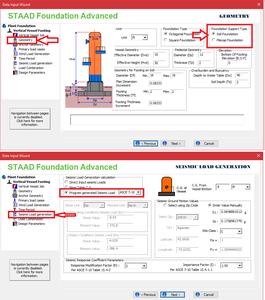
xSTAAD Foundation Advanced CONNECT Edition Update 7 Patch 1
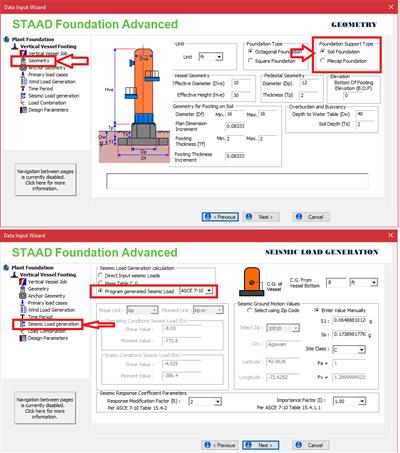
Close
Designing Pilecaps to the Canadian Concrete Code A23.3 2019 edition in SFA's General Mode
The 2019 edition of the Canadian concrete code A23.3 is now available for pilecaps in STAAD Foundation Advanced's General mode using the rigid method of analysis. Another popular analysis method known as the finite element method is available in STAAD Foundation Advanced for mat foundations that are supported on piles and/or soil.
To use the rigid method, you need to select a type of job known as "Pile cap" in the Job Creation page, as described in Pilecap Design per Canadian A23.3 2019.
Defects Rectified
- In earlier versions, the details of some of the piles as well as the support reactions in those piles failed to get reported in the calculation reports as well as in the Output table. This has been corrected.
- The pedestal reinforcement details were reported incorrectly in some places in the calculation reports and output tabs. This has been corrected.
- For pilecaps designed to the ACI codes, some instances were found where the provided number of bars for flexure were reported as 0 in the calculation report. This has been corrected.
- Version 9.6 and older has an error that causes STAAD Foundation Advanced to come up with higher size for isolated footings than the minimum required even though there is significant buffer with regards to bearing pressure and FOS in overturning/sliding. This occurs when some of the load cases in the model have negligible amounts of forces and moments (typically FX and MZ) which although very small & insignificant, are not perfectly zero. This has been rectified.
- Version 9.6 and older has an error that causes STAAD Foundation Advanced to fail to design an isolated footing if there are uplift-causing column reaction loads on the footing, and the design method is Set Dimension. This was found to happen even when the selfweight of the footing, soil weight and surcharge are large enough to counter the uplift causing force. This has been rectified.
- During design for punching shear, while considering the contribution of the unbalanced moment to the maximum corner stress due to punching, the program was taking the larger of the values contributed by the moment terms MX and MZ instead of using their absolute sum. This affected the design of isolated footings, combined footings and pilecaps designed to the ACI codes. This has been corrected.
- For horizontal vessels, vertical vessels and tank foundations, for seismic design per ASCE 7-2005, the SS and S1 values were found to be incorrect if the program was instructed to fetch them from a database of zip codes. This has been corrected.
- In versions 9.6 and older, while determining a suitable plan dimension for the pilecap, the program did not check whether the pedestal or column are so large as to violate the minimum edge distance criteria or even project beyond the edges of the pilecap. This led to a failure during design even if the pile arrangement was found to be suitable for the loads acting on the cap. This has been rectified so that this condition is now checked and a violation is reported right at the beginning before the concrete design of the cap commences.
- In mat foundations, the stability check for overturning was not taking into consideration the pressure loads that are applied directly on the mat. This has been rectified.
- An error in the calculation of the shear capacity enhancement factor in pilecaps for a 3-pile arrangement for the Indian code has been corrected.
- The facility for copying and pasting data from an Excel sheet into STAAD Foundation Advanced's input tables was not working properly for certain types of input, such as the pile-spring data for mat foundations. This error was also present when assigning the thickness to the mat and regions on the mat. This has been corrected.
- In the sliding check for mats, the weight of pedestals (if any are present beneath the columns) was not being considered in determining the overall vertical load in the various load cases. Hence, the resistance to sliding was underestimated. This has been corrected.
- For load combinations created within the STAAD Foundation Advanced environment, the pedestal weight was being considered in any given combination case as many times as the number of basic load cases included in that combination. For example, if there are 3 basic cases included in a combination case, the pedestal weight was being considered 3 times. This has been corrected.
- As part of this correction, the manner in which the pedestal weight is considered for the analysis has been modified. It is no longer applied as a point load on the mat. Instead, the ratio of its weight to the mat's selfweight is computed, and that value is added to the selfweight factor for the mat. Hence, whenever pedestals are present on the mat, the selfweight factor will represent the mat's own weight plus the selfweight of pedestals plus the weight of soil above the mat.
- An error in computing the overturning and restoring moments for load combination cases created within the STAAD Foundation Advanced environment for a mat foundation has been rectified.
- For combined footings designed using the Calculate Dimension method, it was found that in certain models, in the event of loads that are large enough that the program would have to iteratively find the required width, the design was aborted before the maximum permissible width was reached. Consequently, the foundation was considered to have failed the design when there is potentially room to find a larger size. This has been rectified.
- For mat foundations designed to the Australian code AS3600-2018, the moment capacity of the slab for the provided reinforcement was underestimated by about 20%. This has been corrected.
- In version 9.6.1.74, an error in the program made it impossible to create new jobs to the ACI 318-05 and 318-11 codes for foundations in the program's General mode. The same error was also present when attempting to modify the design code to the aforementioned ones for existing jobs. This has been corrected.
- For pilecaps in STAAD Foundation Advanced's general mode designed to the Eurocode with the British Annexe, an error was present in the value reported in the calculation sheet for Vmin for oneway shear design in the local XY and YZ planes. This was only a reporting error and did not affect the outcome of the design. This has been corrected.
- An error was present in the highest and lowest soil pressure that is reported in the calculation sheet for mat foundations if the mat is supported by a combination of soil and piles. The error was caused by the fact that the soil pressure (force/influence area) was calculated by using the force in the pile spring as the term in the numerator, instead of the force in the soil spring. This has been corrected.
- One of the checks performed during the concrete design of the pilecap is the shear due to punching of corner piles through the pilecap. It was found that if the depth requirement due to this check turned out to be larger than the thickness determined from other checks, it was not being reflected in the final thickness reported for the pilecap. This affected various codes such as Australian, Europe, Indian, ACI, etc., and has been corrected.
- For pedestals designed to the Australian code AS3600-2018, an error was present in the value reported for Axial Capacity Ratio. This affected pedestals for all the foundation types in the general mode available for that code. This has now been rectified.
- For vertical vessels on square footings on soil, the bending moment, oneway shear force and punching shear force used in the design were larger than the values obtained from an analysis for the loads acting on the footing. This has been corrected.
- For vertical vessels on square footings on soil, the pedestal weight wasn't being accounted for in some of the calculations. The affected calculations include the soil pressures, and sliding and overturning checks. This has been corrected.
- For isolated footings for STAAD Foundation Advanced's General mode, when the column and the pedestal are both circular, there was an error in the value reported for the critical location (distance from the north-west corner of the footing) for design for flexure about the X axis and the Z axis. This was only a reporting error in the distance, and, did not affect the value of the moment used in the design for flexure. This has been corrected.
- For mat foundations, some improvements have been made in the calculation of "Area of steel provided" in the Reinforcement Zoning pages of the program. This should now result in a more efficient bar arrangement being selected to satisfy the "Area of steel required", as well as rectify errors that caused the steel provided to be less than steel required, in past versions. This improvement has been made for all concrete design codes - ACI, Euro, Australian, Indian, etc.
Minor Enhancements
- It was observed that STAAD Foundation Advanced would hang or crash or produce erroneous results when the Import STAAD.Pro method is used to bring in data from a STAAD.Pro model and a mat foundation is created and analysed, with these operations all being performed in the same session, meaning, without closing the file during any intermediate stage. This has been corrected.
- For mat foundations, an extra set of values will now be reported in the sliding check table, namely, the resultant lateral force.
- While computing the loads on the finite element model of the mat foundation, the lateral loads (FX and FZ reactions) at the base of the column are considered to produce moments at the bottom of the mat (since they act at a height above the bottom), and those moments are applied on the FE mesh of the mat for analysis. An option is now available in Global Settings through which the user can instruct that those moments should be computed at the mid-thickness level of the mat instead of the base of the mat.
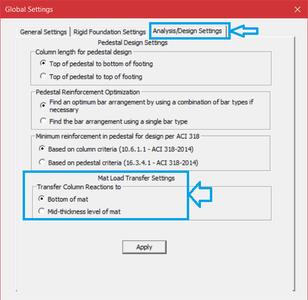
xSTAAD Foundation Advanced CONNECT Edition Update 7 Patch 1
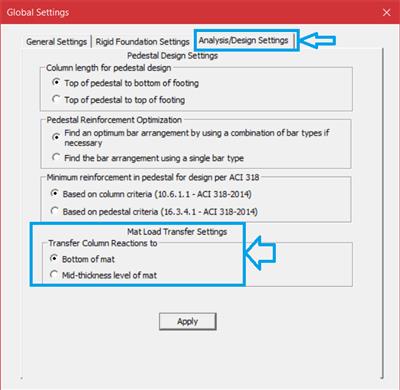
Close
- For foundations in STAAD Foundation Advanced's General mode, the pedestal design has been enhanced to allow users to choose between 2 options for arriving at the main bar arrangement.
a. Find an optimum bar arrangement by using a combination of bar types if necessary
b. Find the bar arrangement using a single bar type.
This option can be selected from Global Settings and is available for all codes for which pedestal design is available from the "General mode".
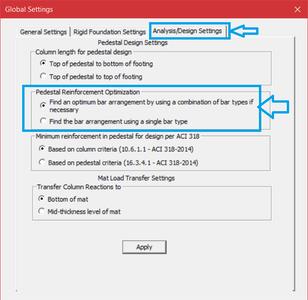
xSTAAD Foundation Advanced CONNECT Edition Update 7 Patch 1
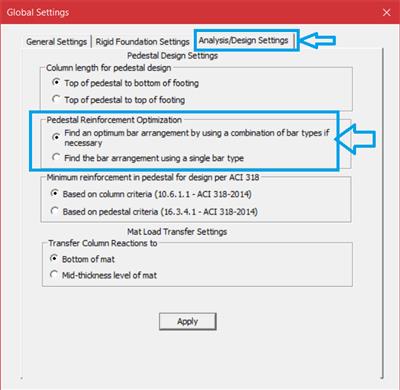
Close
For foundations in the program's General mode, pedestal design per the ACI code has been enhanced to allow users to choose between 2 criteria for minimum reinforcement in the pedestal.
a. Based on column criteria (10.6.1.1 - ACI 318-2014, and, similar clauses in older editions)
b. Based on pedestal criteria (16.3.4.1 - ACI 318-2014, and, similar clauses in older editions)
If Option (a) is chosen, and if only minimum reinforcement is required in the pedestal, the pedestal design output will show an area of steel provided which is equal to or marginally greater than 1% of the pedestal's cross section area.
Similarly, if option (b) is chosen, and if only minimum reinforcement is required, the area of steel provided will be equal to or marginally greater than 0.5% of the pedestal's cross section area.
This choice can be made from Global Settings.
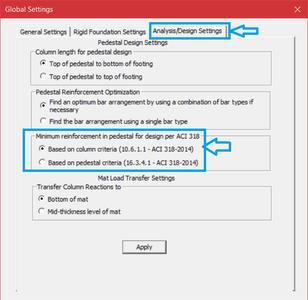
xSTAAD Foundation Advanced CONNECT Edition Update 7 Patch 1

Close
- For mat foundations designed to the Australian code AS3600-2018, in the calculation of minimum reinforcement in the slab, Equation 8.1.6.1(2) and Clause 3.1.1.3 have been replaced with Clause 21.3.1(b) of AS3600-2018. This will lead to a minor reduction in the required steel.
- For the 2-pile arrangement, checks for shear due to punching of the column / pedestal through the pilecap is now performed for Australian, Euro, Canadian and Indian codes. This wasn't being done in earlier versions of STAAD Foundation Advanced.
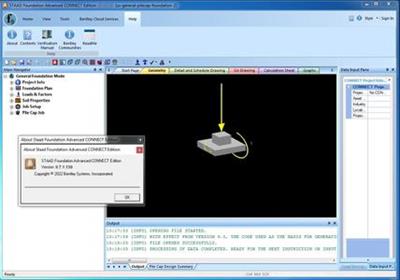
STAAD Foundation Advanceda software package for the analysis and design of a variety of foundations. These include general foundation types such as isolated, combined footings, pile caps, slab on grade or on piles (mat foundations), octagonal, strap, and, plant foundations such as vertical vessel and heat exchanger foundations.
A part of the STAAD family of products, STAAD Foundation Advanced can import and update the geometry, loads, and reactions from a STAAD.Pro model after which it will design the foundation type that we want at those supports. If the type happens to be a pilecap, it can determine a number of pile arrangements and design the pilecap for the arrangment that we choose. Data can also be brought from spreadsheets (e.g., such as that in Microsoft Office Excel®) into STAAD Foundation Advanced.
The output from the program includes customizable reports of the calculations performed, general arrangement drawings, and schedule drawings. The reports are a useful tool for line by line checks to determine the correctness of the calculations if the engineer wishes to do so. The program's graphical interface enables users to view the displaced shapes, shear and moment diagrams, stress distribution, and, reinforcement layout.
For mat foundation designs, STAAD Foundation Advanced creates a finite element model of the mat slab on grade. Soil is treated as spring supports whose stiffness is determined based on the size of the elements of the FE mesh. The model is then analyzed using STAAD.Pro, and, design of the slab is performed by aggregating the results across elements that are clustered into design strips.
Bentley STAAD Foundation Advanced
Bentley Systems, Incorporated.is the global leader dedicated to providing architects, engineers, constructors, and owner-operators with comprehensive architecture and engineering software solutions for sustaining infrastructure. Founded in 1984, Bentley has nearly 3,000 colleagues in more than 45 countries, $500 million in annual revenues, and, since 2001, has invested more than $1 billion in research, development, and acquisitions.
Product:STAAD Foundation
Version:Advanced CONNECT Edition Update 7 patch 1 (09.07.01.139)
Supported Architectures:x64
Website Home Page :www.bentley.com
Languages Supported:english
System Requirements:Windows *
Size:796.5 mb
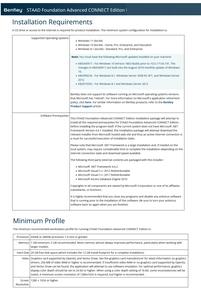
xSTAAD Foundation Advanced CONNECT Edition Update 7 Patch 1
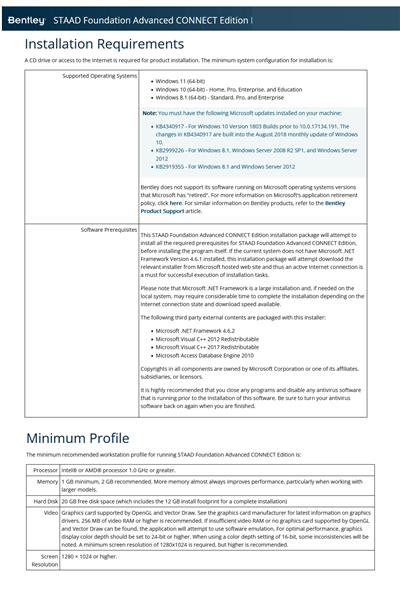
Close
Added by 3% of the overall size of the archive of information for the restoration

xSTAAD Foundation Advanced CONNECT Edition Update 7 Patch 1

Close
Download From UploadCloud
https://www.uploadcloud.pro/yj3sc2dne5x5/zj3fi.STAAD.Foundation.Advanced.CONNECT.Edition.Update.7.Patch.1.rar.html

https://uploadgig.com/file/download/C6b2B31900d724cd/zj3fi.STAAD.Foundation.Advanced.CONNECT.Edition.Update.7.Patch.1.rar

https://rapidgator.net/file/d104515ce2007dff6ed6b9db02402a0e/zj3fi.STAAD.Foundation.Advanced.CONNECT.Edition.Update.7.Patch.1.rar.html

https://nitroflare.com/view/D32A2A5E7A07CCA/zj3fi.STAAD.Foundation.Advanced.CONNECT.Edition.Update.7.Patch.1.rar
https://www.uploadcloud.pro/yj3sc2dne5x5/zj3fi.STAAD.Foundation.Advanced.CONNECT.Edition.Update.7.Patch.1.rar.html

https://uploadgig.com/file/download/C6b2B31900d724cd/zj3fi.STAAD.Foundation.Advanced.CONNECT.Edition.Update.7.Patch.1.rar

https://rapidgator.net/file/d104515ce2007dff6ed6b9db02402a0e/zj3fi.STAAD.Foundation.Advanced.CONNECT.Edition.Update.7.Patch.1.rar.html

https://nitroflare.com/view/D32A2A5E7A07CCA/zj3fi.STAAD.Foundation.Advanced.CONNECT.Edition.Update.7.Patch.1.rar
Links are Interchangeable - No Password - Single Extraction
The minimum comment length is 50 characters. comments are moderated



